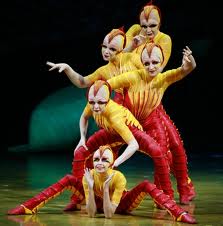Circuses and Oceans
The first time we went to Cirque de Soleil, we took Elliot and a bunch of his 12-year-old buddies. After all, circuses are for kids, right? As it turned out, Suellen and I enjoyed the show just as much — maybe more — than the kids did. I didn’t expect that.
Cirque de Soleil is an excellent example of a mashup innovation. Traditional circuses were for kids. I remember going to Ringling Brothers with my folks. I was dazzled by Uno — the man who could do a handstand on one finger. My parents were troupers but I don’t think they were dazzled. They took me because … well, circuses are for kids.
On the other hand, Broadway musicals are from grownups. They have a bit of a story to follow, they have some conflict, perhaps some mushy stuff, and a resolution. Most of all they have singing. This is where young kids start squirming. I mean, really … how many seven-year-olds want to know that when you’re a Jet, you’re Jet all the way?
The genius of Cirque de Soleil is that it mashes up the traditional circus — get the kids — with Broadway musicals — bring the grownups, too. There’s enough of a story to appeal to Mom and Dad and enough cool (and weird) stuff to appeal to seven-year-olds. It’s family entertainment for modern city dwellers.
While Cirque is a great mashup story, it may be more than that. According to W. Chan Kim and Renee Mauborgne, it’s also a great example of a Blue Ocean Strategy. For Kim and Mauborgne, there are red oceans and blue oceans. A red ocean is full of the blood of competitive strife — it’s red in tooth and claw. The red ocean represents a market of a given size. It’s not going to get any bigger so the only way for one company to grow is to make another company shrink. Strategy is all about defeating the competition rather than winning the customer. As Kim and Mauborgne point out, the market for traditional circuses was very much a red ocean.
A blue ocean, on the other hand, allows you to jump beyond the competition. You create something new and, in doing so, you create a new market where your traditional competitors are irrelevant. The authors offer some great examples of blue ocean strategies and some intriguing and very instructive tips for how to develop one. For Kim and Mauborgne, the genius of Cirque de Soleil is that they have leapt out of the red ocean and into a blue ocean where they rule the waves. Indeed, they’re the only ship in sight.
I’ll report on more blue ocean examples in future posts. At the same time, however, I have a nagging feeling that a blue ocean is not that different from the classic marketing strategy of creating a new category. Once upon a time, for instance, sedans were practical but not much fun to drive. (For my British readers, what Americans call a sedan, you call a saloon). On the other hand, sports cars were fun to drive but not very practical. Then BMW mashed up the two categories and created a sports sedan — practical yet fun to drive. Was the BMW sports sedan a new category or a blue ocean? I’ll report more on that in the future. No matter what you call it, however, mashups are a great way to get there.
